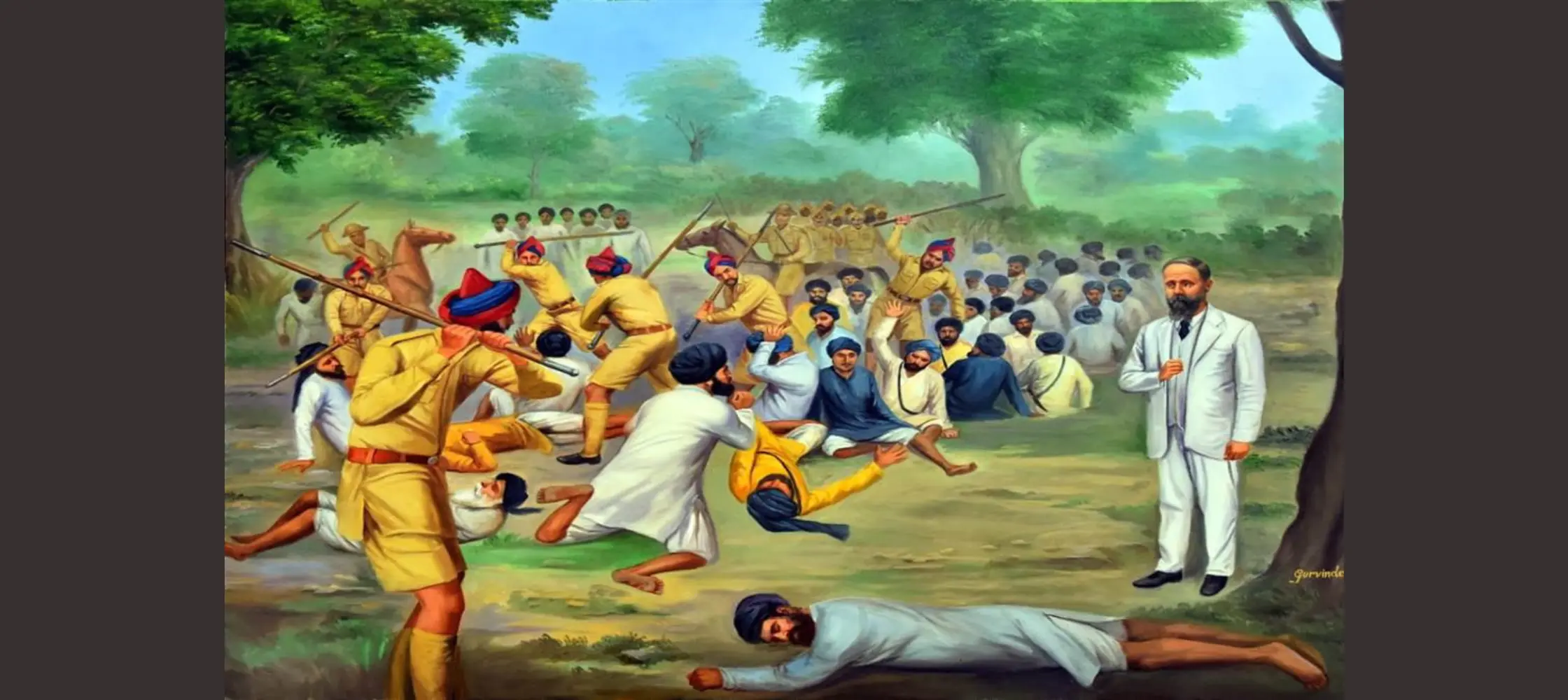
The Guru Ka Bagh Morcha was a significant socio-religious movement in Sikh history. It was Launched in the year 1922, aiming to liberate the Guru Ka Bagh Gurdwara from the control of Mahant Sundar Dass. Situated near Amritsar, the gurdwara holds immense historical and religious importance for Sikhs. The Morcha was a defining moment that not only marked a pivotal struggle for Sikh identity and religious freedom but also showcased the strength of collective action and determination of the Sikh community. The movement highlighted the resilience and unity of the Sikh community underscoring the broader struggle for religious freedom and identity during the time of immense political and social upheaval in India.
Guru Ka Bagh Gurdwara, a revered Sikh shrine, was established in the memory of Guru Arjan Dev Ji, the fifth Sikh Guru, who visited the place in the year 1585 and played a crucial role in shaping Sikhism.
Over time, various Sikh shrines came under the control of mahants, who often exploited their positions for personal gain, leading to growing discontent among the Sikh community.
In the early 20th century, the Sikh community was grappling with issues related to their religious and cultural identity. The British colonial rule facilitated encroachment of religious institutions by powerful individuals known as mahants, who would exploit the religious sentiments of the devotees for own vested interests. This situation arose due to the British policy of providing legal recognition to the hereditary custodians of religious places.
By the early 20th century, the Guru Ka Bagh Gurdwara had fallen under the control of Mahant Sundar Dass. His mismanagement and disregard for Sikh principles and practices led to widespread anger among the Sikh populace. The Mahant's actions were perceived as disrespectful to the sanctity of the gurdwara and the Sikh faith. In response, a group of Sikh leaders and activists emerged with the intention of reclaiming the gurdwara and restoring it to the Sikh legacy and thus launched the Guru Ka Bagh Morcha. The morcha, or movement was aimed to peacefully reclaim the gurdwara from Mahant Sundar Dass and restore its administration to the Sikh community.
As the Mahant was adamant not to peacefully handover the possession of the Gurdwara to the Sikh sangat, it was decided to dispatch a batch of five Sikhs daily to cut firewood from the grove of trees on the land of the Gurdwara and court arrest if stopped from doing so. The police of the English regime, however, began to arrest devotees’ jathas accusing them of theft, riot and criminal encroachments. The action of arresting the Jathas gave further boost to the movement leading to joining of the Morcha by more Sikhs. As the Morcha grew in strength every passing day, the police of the day started using force by lathi charging the Sikhs participating in the agitation. The disproportionate use of force by the government against the protesters inspired the Morcha as the marching Jathas increased in their size and strength. Instead of reading the writing on the wall, the government raised the bar and issued warrants for the arrest of eight members of the executive committee of the SGPC and also banned the assembly of people at Guru Ka Bagh. The jathas going there daily kept braving the brute force of the police.
However, when the Governor of the Punjab visited Guru ka Bagh on 13 September 1922, he ordered the police to stop beating the volunteers of the Morcha. But mass arrests, imprisonments, heavy fines and attachment of properties were resorted to.
Later, with a view to solving the issue, the Governor General Lord Reading held discussions with the Governor of the Punjab to devise some ways to break the impasse. Services of Sir Ganga Ram, were utilized to resolve the situation. To help resolve the issue, Sir Ganga Ram acquired on lease a large piece of land of the Bagh from the Mahant and allowed Sikhs to use it resulting in the end of the Morcha. Prisoners were released. According to an estimate, more than 5000 Sikhs went to jail in the course of the Morcha. The legacy of the Guru Ka Bagh Morcha continues to inspire Sikh activism and the fight for religious rights and freedom. The movement served as a precursor Sikh struggles in later years with the purpose of reclaiming Sikh shrines from the control of mahants and the colonial administration.
In nutshell, the Guru Ka Bagh Morcha stands as a symbol of the Sikh community's resilience, unity, and determination in the face of challenges. The movement's success in liberating the gurdwara from the clutches of Mahant Sundar Dass was a victory not just for the Sikh community, but also for the larger principles of justice, religious freedom, and self-determination.
Your email address will not be published. Required fields are marked *
29 Jan, 2024
29 Jan, 2024
29 Jan, 2024
25 Jan, 2024